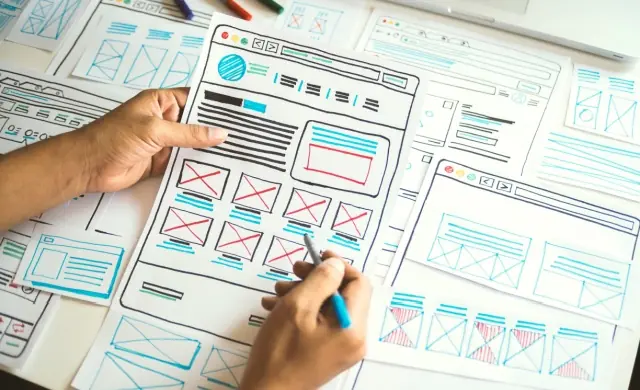Money moves fast online. Fintech web design decides who keeps up. Across India’s buzzing fintech industry, customers tap, swipe, and scroll for loans, insurance, and investments in seconds. They judge fintech websites in the blink of an eye. Pages must load fast, explain clearly, and look great on every screen. Responsive web design is now a survival skill, not a style choice. From sleek start-ups in Bengaluru to legacy banking websites upgrading portals, the race is on to turn first-time visitors into lifelong users. Pushing pixels is only half the job; pushing trust is the other.
Winning that race needs brains and craft. A trusted user experience company studies daily pain points, then applies sharp UI UX design to fix them. Smart design elements—progress trackers, nudges, crisp summaries—cut confusion and boost confidence. Pair them with an intuitive mobile app, and you create an effective fintech journey that customers enjoy and recommend. Security still sits at the core, yet today’s users also expect friendly animations and instant support that feels human. Master this balance, and your fintech products will move from download to daily habit. Here, fintech web design becomes the quiet engine powering growth.

What is Fintech Web Design?
Fintech web design blends sleek visuals with iron-clad security to earn instant trust. Indian users click fast, so every pixel must guide them smoothly. Strong choices start with solid user research and a dash of design inspiration drawn from the best money apps.
At its core, fintech web design is the craft of building online finance hubs that feel trustworthy, simple, and safe. Designers map smooth journeys with UI UX principles, then craft polished fintech sites that fuse clean visuals with bank-grade encryption.
Benefits of Fintech Web Design
- Builds trust quickly, so users sign up and share data without worry.
- Supports inclusive UX design, letting people of all ages and abilities manage money easily.
- Shortens task flows, which lifts conversion rates and cuts support calls.
- Scales across devices, meaning one codebase serves desktops and thumb-friendly screens.
- Sharp visuals and clear copy boost brand recall, turning one-time visitors into long-term customers.

Business Case: Why Design Dictates Profit in Fintech
Design may look like décor, yet it drives the money meter. One fintech app trimmed load time from 5 to 2 seconds and saw bounce drop from 38% to 9% – users stayed, wallets opened.
A clean layout, swift pages, and punchy micro-copy turn browsers into buyers. A sharp UX research agency tests every word and colour, then swaps clutter for clarity. Navi’s lending revamp proves the payoff: a 21% fall in form drop-offs and a 10% rise in loan disbursals within three months.
Syfe’s redesign increased conversions by roughly 25%, showing that fresh flows mean fresh revenue.
The cost of poor security is steeper. A single breach now averages INR 195 million in India’s finance sector, money that could fund a full product sprint – and then some.
So teams partner with a UI UX design agency that bakes bank-grade shields into every pixel while keeping the user experience light. Thoughtful design elements such as big-font sliders and contrast boosts also meet banking web design for senior citizens, widening the customer pool at no extra marketing spend.
Strong visuals help B2C wallets, yet smart B2B UX design lifts enterprise dashboards too. After all, treasurers need the same speed as teens on UPI. Add professional touch interface design and slick web development, and your fintech platforms feel as fluid as they are safe. The result? Modern, trust-first fintech web design that boosts sign-ups, deposits, and cross-sells – then keeps those gains. Good design equals loyal customers, period.

Foundational Principles: Security, Compliance, and Clarity
India’s digital wallet boom is thrilling yet unforgiving. Secure, compliant, and crystal-clear fintech web design now separates winners from the rest, because one misstep invites fines or exits. Below, see how smart rules, solid defences, and plain words keep the rupees rolling.
GDPR
Show respect for EU visitors by adding geo-IP consent banners and neat data dashboards. This user-centric design explains choices in plain language and builds trust fast.
PCI-DSS v4.0
Tokenise card fields, encrypt traffic end-to-end, and require multi-factor login. Real-time fraud alerts pop up with push technology in web design, so users stay safe without refreshing.
RBI KYC Master Directions
Slip a video-KYC step into onboarding with big fonts and colour-coded risk flags. Seniors breeze through; younger crowds race ahead.
These tactics guard every fintech business while keeping fintech websites fast and friendly. Strong shields also lift user experience, proving safety need not slow growth. Leading fintech companies now run quarterly UX audits to check cracks early, then patch them with enterprise UX design baked in modern design patterns. A well-designed fintech platform mirrors these gains in its mobile app design, giving one smooth story everywhere.
Tip: Test every release with penetration and accessibility audits.
Done right, fintech web design turns dry regulations into durable loyalty.

Experience Drivers: Trends Users Expect in 2025
Badges, split bills, and invisible payments will drive fintech web design in 2025. Amid India’s digital boom, staying ahead of fintech trends means pairing modern design with rock-solid safety so every tap feels fun, fast, and trustworthy. Below are three shifts your product team can’t ignore.
Gamification Makes Saving a Game
Indian fintech companies like CRED keep users returning with badges, leaderboards, and daily “spin-to-win” wheels. Engagement platforms report jumpy repeat-login curves when points and progress bars appear on screen.
This user-centric design turns dry goals into dopamine hits. Tactical add-on: slip a progress bar that fills as monthly targets are met.
One-Tap Money Movement Becomes Default
UPI processed more than 13 billion transactions in March 2025, proving Indians now expect cash to move at thumb speed.
Clean screens, pre-filled payees, and a single-tap “Pay again” button answer the key needs of a fintech website. A touch-friendly, minimalist design keeps CTAs in the thumb zone and shaves seconds off every send.
Social Banking Turns Finance into Teamwork
Users want shared goals, saving circles, and instant splits that feel like chat. Monzo’s new Split tool nails the idea: “We built Monzo Split so you don’t chase friends,” says CPO Andy Smart.
In the fintech space, web designers and developers can mirror this by adding group vaults with live emoji avatars – community plus cash in one tap.
Keep the Sparkle, Guard the Clarity
Innovate bravely, yet never hide costs or clutter flows. When delight meets transparency, fintech web design turns fresh ideas into lasting trust, proof that disciplined web design and development pay for itself.

Execution Blueprint: Research → Prototype → Test → Iterate
Great apps start with a plan, not luck. This blueprint walks through research, prototypes, tests, and tweaks, showing how each phase lifts fintech website design from idea to income. Follow it and watch a concept turn into a successful fintech that customers trust.
User Research
Start with user research. Interview real customers, run Hotjar heat-maps, and record tasks to spot every stumble. This early sprint shapes the design process for fintech startups, revealing hidden blockers. Fix top pain points before drawing any pixels.
Rapid Prototyping
Jump to prototypes. Build low-fi wireframes in Figma, share clickable demos within two-week sprints, and refine fast. Apply solid design principles and best practices, aiming for a clean, straightforward design that mirrors fintech web design patterns users already trust. Ship the draft and gather instant feedback.
Validation Testing
Test – don’t guess. Run Optimizely A/B experiments on flows, trigger security scans, and tick compliance boxes. A UI UX design company measures conversions and risks side by side, proving which variant grows revenue. The outcome is a well-designed fintech website that feels bulletproof.
Continuous Improvement
Release day is half-time. Feed Mixpanel data, spot churn, and push weekly fixes. This design that prioritizes user experience moves toward the ultimate goal of any fintech company: trust and growth. Keep building a fintech website that people revisit, showing fintech web design success is always a living metric.

Selecting the Right Fintech Web Design Partner
Picking a partner for fintech web design feels like choosing a co-pilot for a rocket launch. The fintech industry is rapidly scaling, regulations are tightening by the month, and users expect banking to be as smooth as music streaming. A sloppy pick drains cash; a smart one prints it.
Proof first. When launching a fintech website, demand evidence of PCI-DSS builds or ISO 27001 audits. S-PRO, for instance, showcases end-to-end compliant projects for banks and wallets, ticking every European and Indian box. Inbound FinTech’s twin ISO badges prove that data is treated like bullion.
Speed next. Fintech startups can’t afford ping-pong between vendors. ScreenRoot’s in-house UX researchers, UI designers, and full-stack developers work side by side, so ideas move fast and quality never slips. Fewer hand-offs mean more launch days.
Reliability seals the deal. Even the most well-designed fintech website fails if it crashes on payday. Lock uptime, audit cadence, and roadmap sprints into a written SLA; guides from SPD Technology show how these clauses guard both sides.
Colour still counts. Fintech websites often default to calm blues, but a bold design choice to use vibrant gradients can lift recall without spooking compliance teams – if the partner knows their contrast rules.
Ask the right questions, and your fintech web design partner will turn regulations into revenue.

ScreenRoot: Your Shortcut to Fintech Web Design Success
Smart code matters, yet design moves the needle. The journey we mapped—research, rapid prototypes, relentless testing, and tidy iterations—shows how every pixel can cut friction, build trust, and win loyalty. When these steps align, the result is a successful fintech website that loads in a flash, explains in plain words, and never blinks on payday. That level of polish demands more than templates; it needs a fintech web design agency with proven craft, iron-clad process, and deep expertise in fintech.
ScreenRoot ticks those boxes. Our teams blend behavioural insight with iron-clad compliance, then wrap both into lean, lively interfaces. Whether you are scaling payments or launching a new fintech, we plug in fast. You gain market-ready pages, secure flows, and room to grow—without hiring twelve vendors or waiting twelve months. Plus, we bundle UX audits, UI refreshes, and full-stack builds into flexible fintech services, so you choose only what you need.
Ready to shorten the runway? Speak to our fintech design specialists today to slash time-to-market. Explore the projects we have delivered for banks, wallets, and neo-lenders on our Work page. Call 1800 121 5955 (India), email [email protected], ping us on WhatsApp, or drop a note via the Contact form. Let’s turn your vision into the next headline fintech success—quickly, securely, beautifully.







